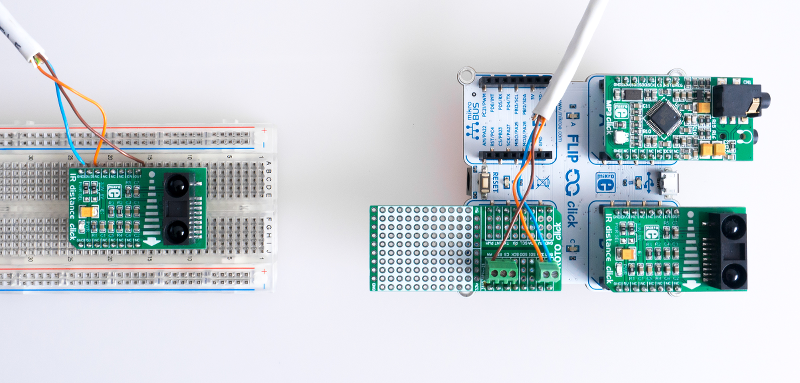The traditional theremin is more or less an audio oscillator with two metal rods. Using proximity sensing, one rod controls the pitch of the oscillator and the other controls the volume. [Teodor Costachiou] apparently asked himself the excellent question: Why does the proximity sensor have to use capacitance? The result is an Arduino-based theremin that uses IR sensors to determine hand position.
[Teodor] used a particular type of Arduino–the Flip and Click–because he wanted to use Click boards for the IR sensors and also to generate sound via an MP3 board based around a VS1053. The trick is that the VS1053 has a realtime MIDI mode, and that’s how this Theremin makes it tones.
Of course, a real theremin is distinctly analog. A tiny change in hand position creates a small change in the output. With digital sensors and sound generation, the output is more in discrete steps, but according to [Teodor], the effect isn’t bad. We were hoping for a video (or, at least, an audio clip) but [Teodor] pleaded that he’s not a musician. He did include a video of a real theremin performance with his post, and you can see it below. But that’s a real analog theremin.
If you want to build something more traditional, have a look at Open Theremin. Or, if you want to get your exercise, how about trying a terpsitone. If you do, and can play the theme to The Day the Earth Stood Still, we’d love to see the video. Meanwhile, if you didn’t know the theremin had an espionage connection, you haven’t been staying current on Hackaday posts.















Actually a traditional theremin is a couple of RF oscillators which are detuned by proximity, and the output is a beat frequency; this is why such small changes in capacitance as caused by your hands being nearby can actually create such a large audio frequency shift.
Cheap “light theremins” using a photocell and transistor audio oscillator were a staple of the n-in-one Radio Shack electronic project kits of the 1970’s.
The sensor is analog and gives analog output. I don’t know much about these flip-stick-click-lipstick, but I think it can be done using PWM rather MIDI to be more like theremin than auto-tuned device.
I will have to look into these sensors. Digital and analogue out I would hope. But I can see where this might go, (let ‘duino do all the work) playing a equal-tempered scale of limited range. Still these sensors could be used for filter or other parameters in a synth audio setup.
I get 5 octaves in 32 inches on what would be if Tesla and Therman made an electric slide guitar. The top octave is just 2 inches long, but it’s playable. It can sing up there like a diva at the Met!
That hand shacking for the vibrato … sorry, dirty mind.